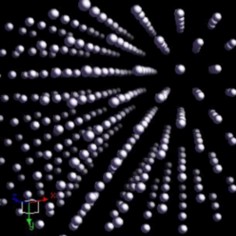|
Scientists are figuring out the physics behind
a seemingly magical way to produce high-quality crystals.
by Patrick L. Barry
"Any
sufficiently advanced technology is indistinguishable from magic."
Arthur C. Clarke
At first, it might remind you of a
magician making his assistant levitate above a table, apparently
suspended only by the power of the magician's mind.
But this is a laboratory - an unlikely
setting for such a show. Nevertheless, it's where Frank Szofran
and colleagues are growing high-quality
crystals using a method as amazing
as any conjuring trick.
By carefully cooling a molten germanium-silicon
mixture inside a cylindrical container, they coax it into forming
a single large and extraordinarily well-ordered crystal. Such crystals
have very few defects because, remarkably, they never touched the
walls of the very container in which they grew.
Amazing. But like the spectacle of
the lovely levitating lady, the sense of "magic" elicited by this
way of making crystals is only a product of not fully knowing how
the trick is done.
When this crystal-growing procedure was serendipitously
discovered in experiments flown on Skylab
missions in the 1970s, scientists were as baffled as an audience
at a magic show. Since then, crystal growers have begun to piece
together an explanation, but there are still unanswered questions about the process
- called "detached Bridgman growth."

Image courtesy WebElements.com
A close-up view of atoms in a germanium crystal.
(The spaces between the atoms are exaggerated for clarity.)
The goal of Szofran's crystal-growing experiments is to
minimize the defects in the orderly arrangement of the atoms.
|
Growing well-ordered crystals is important
because they are used in a mind-boggling variety of devices here
on Earth: microchips, video cameras, radiation detectors, digital
watches, high-power semiconductors, and record players, to name
a few. Crystals formed by detached Bridgman growth, in particular,
could lead to improved windows and substrates for infrared sensors,
more accurate cosmic-ray detectors, and tiny solid-state lasers
for next-generation flat-panel displays. And hard-to-predict spin-offs
could create whole new categories of electronic products.
"In general, when people grow crystals [for electronics
applications], they would like them to be the highest quality possible
- the lowest number of impurities, the lowest number of dislocations,"
Szofran says. Detached Bridgman growth is one way to make that happen.
Szofran explains: "When crystal growth takes place
in contact with the container wall, the container pushes on the
crystal, and that causes the atoms to be nudged out of alignment.
Such 'defects,' as they're called, can cause the crystal not to
perform as well [for certain applications]."
During detached Bridgman growth, the crystal doesn't
touch the container walls, so a higher quality crystal with fewer
defects can be produced.
An ideal crystal is a paragon of order and structure. The atoms
that comprise it are arranged in a geometrical pattern that repeats
over and over - like the tiles in a tile floor, but in three dimensions.
The precise ordering of atoms can lend a crystalline
substance special properties of use in, e.g., electronic
devices.
Although detached Bridgman growth
was discovered during experiments done in space, scientists have
learned how to grow crystals using this method on the ground, too.
That's important because, otherwise, it wouldn't be of much use
to industry.

Image courtesy MSFC
The surface of this crystal grown by the Bridgman
method is visibly smoother where it was detached from the
container wall. The "hands off" growth of detached Bridgman
crystals creates fewer defects in the crystals' internal
structure.
|
It's too expensive to grow bulk quantities of inorganic
crystals in space, Szofran says. The purpose of space-based experiments
"is to learn about the process of crystal growth, which hopefully
can then be applied to improve the way crystals are grown on Earth."
Growing crystals in space is revealing "because,
in a sense, gravity is a variable," he explains.
"Any time a scientist can gain control over a variable, they can
learn more by changing its value and doing experiments under different
conditions."
Here on the ground where gravity is
"normal," Szofran and colleagues are studying crystals grown from
an alloy of germanium and silicon - materials with well-understood
properties thanks to decades of intense research by the semiconductor
industry. He notes that other materials are candidates for detached
Bridgman growth, too, including alkali halides used in cosmic ray
detectors; indium antimonide and gallium antimonide, which are used
for infrared detectors and lasers; and calcium fluoride for short-wavelength
lenses used in ultra-high definition lithography.

more
Many inorganic solids have a crystalline structure. This
diagram shows the arrangement of atoms in a "unit cell"
of germanium. The spaces between the atoms are exaggerated
for clarity.
|
Their ongoing experiments
aim to answer some important questions. For example: What causes
the crystal to grow detached from the walls of its container?
and What is the exact range of conditions in which detached growth
can happen? Szofran says that, "a breakthrough in our understanding
of detached terrestrial growth could lead to commercial technologies
for preparing advanced semiconductor materials with reduced defect
densities, while a better understanding of detached growth in microgravity
could allow crystal growers to better control this phenomenon during
future flight experiments."
Szofran is looking forward to 2004 or 2005, when
he and his colleagues will be able to conduct crystal-growing tests
aboard the orbiting International Space Station. The results could
provide the understanding they need to master this "magical" technique
and to produce crystals of exceptional quality right here on Earth.
|
